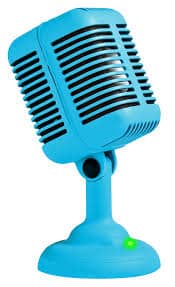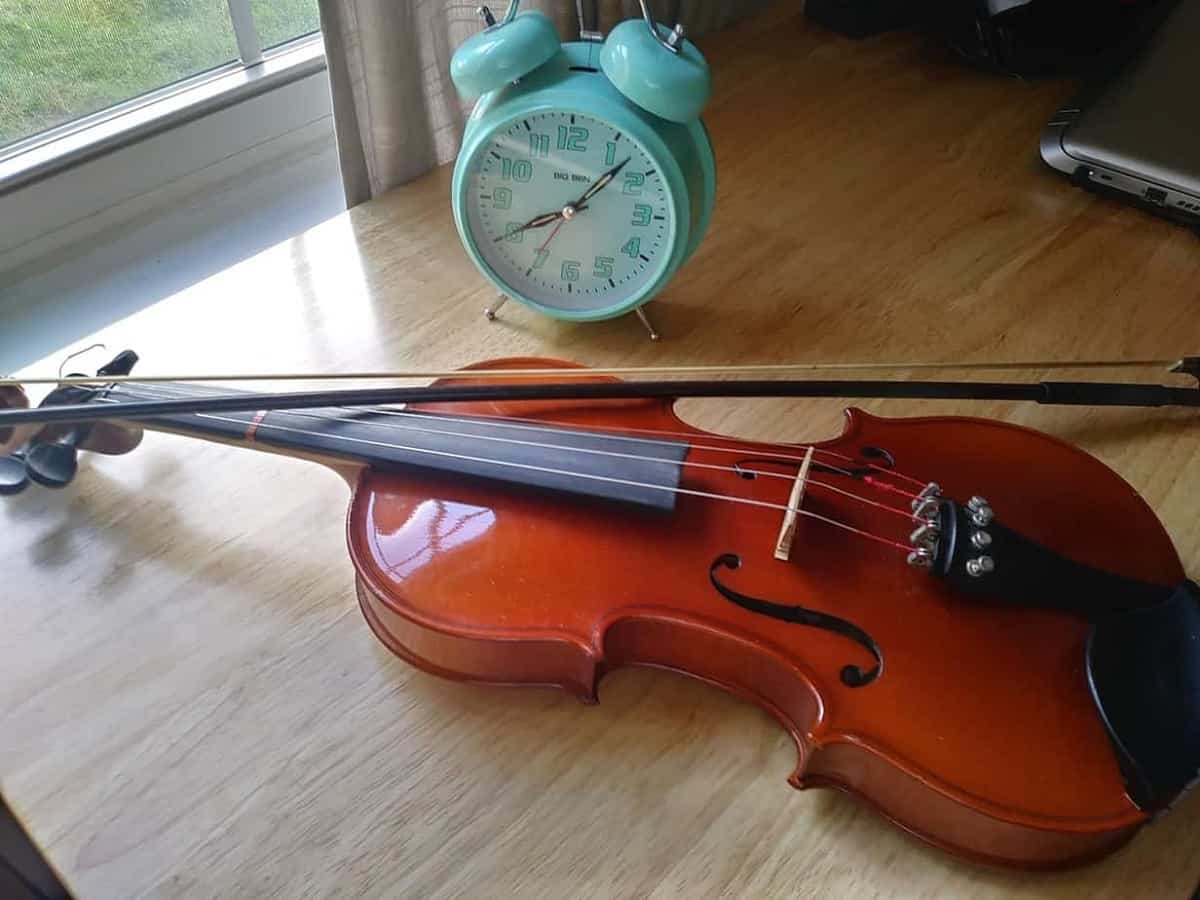Achieving the warm acoustic sound that can replicate a Fiddle or a Violin is a matter of experimentation but there are various positions without using close miking. This is what some players feel is a better way of doing it. The best way is the way that lets the stringed instrument sound the most natural. How to Record a Violin?
Small diaphragm condenser mics with a flatter response are typically used directing the mic at the tail end of the f-hole on the bass side of the fiddle in an attempt to get a better-balanced tone. 21 in. – 3 ft. above & slightly to the front of the fiddle for a fiddly sound with more bow definition.
The sound from placements can be subjective and should be a start and listen then decide how much room and mic position for the Fiddle and Player with some trial and error.
Violin Microphone
Condenser Microphones have the capability to pick up a broad range of frequencies and therefore are used to replicate a natural sound, condenser mics (both small and large-diaphragm) are probably the most commonly used microphones to record acoustic instruments. They can be used for numerous duties and assigned to different signals.
Omnidirectional microphones have the great advantage of picking up sound evenly from all directions. Using an omnidirectional microphone is appropriate when you want to pick up the full sound of the instrument and you can maneuver it using a gooseneck a short distance away from the instrument. As a start, some sound engineers would say about 3 feet, not any closer, or the sound can be scratchy. Of course in a larger room with a higher ceiling and more air, the sound would definitely benefit.
Large-diaphragm condensers mics are often used to record vocals because they tend to capture a big sound, often with a lot of high-frequency detail (though this varies quite a bit model to model). When miking a Fiddle it’s very important for a mic to be able to capture the high-ends coming from the instrument but then again, too much is not good.
It’s often the amount of high-end detail that determines whether a mic is good for the fiddle or not. Fiddles can make a lot of noise with the bow, sometimes scratchy squeaky just awful and need to be adjusted and tweaked to find the right balance.
If you’re paying for studio time, no doubt microphones like the Neumann U47 found on Amazon and recommended by MikingDesign.compare a large-diaphragm tube condenser mic, that is a fantastic-sounding microphone. It sounds big, warm, natural, and costly.
For your Home Recording Studio something more in an average budget that really sounds great for the price. Audio-Technica AT4040 Cardioid Condenser Microphone Bundle with Pop Filter, XLR Cable, Shockmount, case, and cover found on Amazon I like the sound of this mic. It’s warm and easy to control. The built-in low cut and gain features make setting this up a breeze. The sound quality is fantastic. Mid-range price with a lot to offer check this one out before you leap out and go for big money mics.

Audio-Technica AT4040
- A DPA 4011A Cardioid Mic -Specifications Directional pattern Cardioid Principle of operation Pressure gradient Cartridge type Pre-polarized condenser Frequency range 20 Hz – 20 kHz Frequency range
- Schoeps cmc64 mic or an AKG C481
Small diaphragm condenser mics tend to be the first choice for recording fiddle. The rep on SDCs is that they generally capture the sound of your instrument without favoring or “hyping” any particular range of frequencies. Often true, but not always. The flatter the frequencies the better.
Neumann KM84 like this found on Amazon and most Professional Studios is a tube-less mic just about every medium-to-large studio has at least a pair of these and for good reason. A fairly flat, neutral frequency response, so a good and versatile choice for acoustic instruments including the Violin or your Fiddle as we call it.
Small-diaphragm condenser mics (SDCs) like the M-Audio Pulsar II: For your Small Home Studio A good, neutral-sounding SDC in the same price range as the Pro 37.
AKG C1000S High-Performance Small Diaphragm Condenser Microphone for your small home studio on a budget. Known as the Swiss Army knife of microphones for vocal and instrumental recording, on stage, in ENG/EFP, and video production. The updated version of the C1000 S multipurpose small-diaphragm condenser microphone is extremely popular for its versatility. It is suitable for recording and living sound applications
Wireless Violin Pickup
If you are playing with others on stage and you want less challenge from trying to mic your Fiddle then a Pick-up is for you. For recording, it will sacrifice some sound quality but depending on which one you use can maintain most of the sound you desire. Though mostly for live play especially where a player tends to move around on stage, it’s less of a hassle.
The room is a natural processor when playing a Fiddle that you will sacrifice if you use a Fiddle Pick-up. You will have the same response to using a pick-up on acoustic guitar. It may work on stage because it’s needed on stage.
Your priority when recording in you’re Home Studio should be to find an acoustic space worthy of the performance, and then work out how to record there. Find the sweet spot as you would on any stringed instrument and use proper microphone placement and record, note and try again to get the best acoustic offered up in the space of the room. Fiddle pick-ups are for playing live when conditions don’t allow for all that. So leave it out of the recording mix.
It is an advantage, to use one mic whenever feasible. It’s simple, elegant, and reproduces the sound of your instruments far better than any pickup would
Microphone Techniques for Recording Fiddles
Close miking will always take elements away from the sound and possibly add undesirable elements that ruin the sound that is being recorded. If you want a natural, full-bodied sound from a violin, you have to give it space. Where the Fiddle might sound better a little bit closer. The extra rhythm added to the style of say, Bluegrass will sound better closer.
Still, close-miking will always sound more colored by comparison and there will be a disproportionate amount of mechanical bow noise squeaking and scratching that find their way into the high-end frequencies. The less you add at the beginning the better scenario you have to work with. That would be the player-the Mic and the Room. Leave out the preamps and converters because less is best.
Fiddle/Violins can accept digital reverb very well. So you can track dry and add it later. Just keep the mic out at 3-4 feet and slightly above the instrument looking down on the body of the violin. Select a mic that has the flattest frequency response curve available to you.
Recording in stereo or X-Y will depend on the Room size and the amount of air. Space and imaging you are looking for. All the techniques that are available depend on the Room and its size and ambiance and you won’t know until you make some tracks and then experiment with them. So keep the preliminary effect down or zero. As we mentioned earlier Violin can accept digital reverb very well, so record the tracks dry and add it in later
Overhead miking is a pretty common way of micing a fiddle or violin. For a violin, you want farther away (to emphasize the fullness of the sound), but for fiddles, the mic is placed closer to get some clarity for the bowing rhythms. Here is where to place the mic in relation to the fiddle for the best sound.
How to Mic Violin Live
When recording my daughter who’s been playing violin/fiddle directing the mic at the tail end of the f-hole on the bass side of the fiddle in an attempt to get a better-balanced tone than what is normally achieved directly at the bridge.
- Use a small-diaphragm omnidirectional mic- they will sound more natural than Cardioid microphones. With some extra edge and detail that is demanded by Fiddle playing in Bluegrass.
- Whatever mics you choose, Use a Flatter Response Microphone and avoid anything with a big presence peak and invest plenty of time in experimenting with both the position and height of the mic(s) around the player.
- Record in a room with lots of wood involved with the construction. The more wood the more tonal qualities the Room can add to the balance of the mic.
- Use the space to add more presence and luster for a Violin type of sound or genre of music or tightening it up will add a more rhythmic attribute to the sound quality that you would need for Bluegrass or Country Rock sound quality.
- Don’t use any processing until the recording is done.
- About 7 feet above and slightly to the front and right of the Fiddle for a full violin sound
- About 21 inches but no more than 3 feet above and slightly to the front of the fiddle for a more fiddly sound with more bow definition
- Over the shoulder near the ear pointed at the left f-hole balanced sound similar to what the left ear hears
From my humble experience from years of chasing the sound, I’ve learned that a Room, a Player, and Mic are the most important parts of the collaboration in making a recording.
What is a Boundary Microphone
JimGalloway Author/Editor

MikingDesign.com


